Audrey, aka Skipper, and I built ST. JACQUES, our little Penobscot 14, to row out on a nice day and ride back with the wind and tide to our launch spot. While I row, Skipper takes the helm and steers. She occasionally nods off, and we may veer off course. We recently added a nice piece of gear, the WaveFront TillerClutch, which can keep us on track while Skipper snoozes. And when I take ST. JACQUES out for a singlehanded row and sail, I can now have the TillerClutch mind the tiller while I attend to the many other nautical bits that often keep me pretty busy.
The TillerClutch works by locking on a control line that is run under the tiller and anchored port and starboard. When the device is activated by flipping the control lever down, it holds the tiller in the set position. Squeezing the lever partially upward momentarily releases the hold on the control line for quick adjustments. For an unrestricted tiller, the control lever is set in the full up position to allow the tiller to swing freely. In this position, there is enough clearance between the lever and the tiller to prevent finger pinching.
The body and handle are machined from marine-grade aluminum alloy, and the clutch spring and rivets are made from Type 316 marine-grade stainless steel, which has been passivated (treated with acid to create a protective oxide coating). The internal lever bushing is made from a self-lubricating synthetic material that requires no maintenance beyond a periodic freshwater rinse. The bushing also acts as an insulator to prevent dissimilar-metal galvanic corrosion. The body measures 3 1⁄8″ × 1″ × 1 1⁄8″, and the control lever toggle is 2 1⁄4″ long. The finish is superb, and the rounded edges of the control box feel smooth and safe to the touch. The clutch body can be mounted to tiller surfaces that are flat, rounded, or circular, with the recommended mounting location being on the underside of the tiller.
 Photographs by the author
Photographs by the authorThe TillerClutch offers three positions: fully engaged the clutch holds the tiller in a set position; partially engaged allows the helmsperson to move the tiller for course adjustments; fully released disenages the clutch so that the tiller can be used without restriction. The clutch is operated with a gentle squeeze of the hand.
The TillerClutch kit comes with an owner’s guide, detailed installation instructions, 12′ of 3⁄16″ braided control line, and two 1 3⁄4″ stainless-steel screws. WaveFront also sells additional hardware to facilitate installation, including V-cleats, cam cleats, pad-eyes, and even tillers. While the instructions call for installing the clutch 6″ to 7″ from the forward end of tiller, we installed it within Skipper’s easy reach from her accustomed perch well aft in the port quarter. She can still lean back against the transom, rest her arm on the tiller, and click the clutch on and off with the flick of a finger. This sternward clutch position lessens the mechanical advantage the clutch has to resist slipping, but our helm is very well balanced. Boats that have a heavier helm may need to have the clutch farther forward on the tiller.
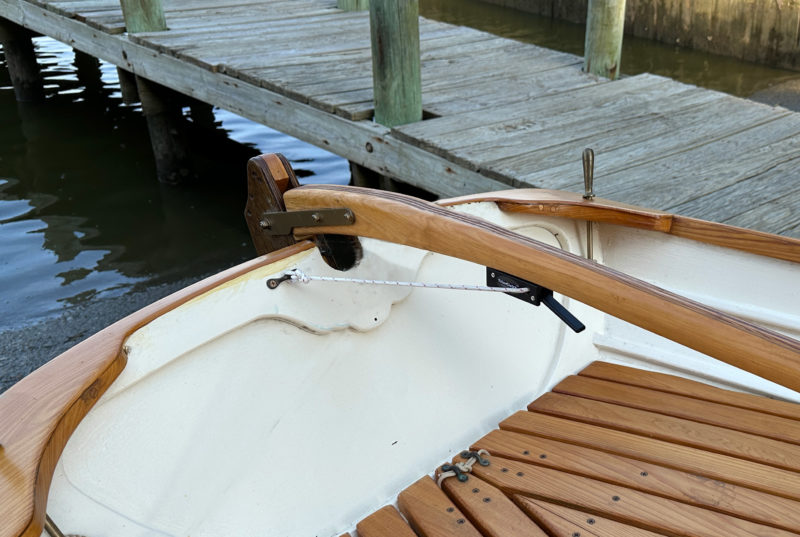
The manufacturer recommends mounting the tiller 6″ or 7″ from the forward end of the tiller to keep it close to hand and also to maximize the mechanical advantage. They also recommend temporarily strapping the clutch to the tiller in order to find the optimum position before final fitting. The authors decided to mount their clutch farther aft so that it is within easy reach when leaning back on the transom.
We took the option provided in the instructions for small boats and attached the control line to pad-eyes fastened to the transom. With the lines back to the transom and close to the tiller’s rudderhead pivot point, we are still able to raise our tiller to its maximum limit. For larger boats, the control line is led through fairleads on the transom, then forward to jam cleats so the line can be released for unimpeded access to the stern or raising the tiller. For our boat, we only need to be able to remove the rudder for trailering, so one end of the line is secured with a bowline and on the other end we use several half hitches, so that we can slip the control line out of the clutch body.
The control lever is easy to operate and has a positive feel when shifted between the locked and unlocked positions. Under normal sailing and rowing conditions, the TillerClutch handles the rudder loads without slipping, and the tiller can also be repositioned in an emergency by pushing or pulling the tiller with more than 15 lbs of force to override the friction created by the clutch when it is engaged. When Skipper steers and I row, she usually unlocks the TillerClutch, but she has the option of locking it when she’s fixing to doze off. When I’m singlehanding the boat, I am very happy with the assistance provided by the clutch. It keeps the tiller straight while I’m rowing and when I’m sailing and need to move forward to tend the sail or centerboard. The TillerClutch is also very handy when transitioning between rowing and sailing.
The TillerClutch is working great and is allowing us more freedom on ST. JACQUES. It’s like having someone else aboard to mind the tiller. Made in the USA, it comes with a lifetime warranty, and the company has been very responsive to emails.![]()
Audrey (Skipper) and Kent sail and row around the Tidewater region of Virginia when not restoring boats. They blog their mess-about adventures at Small Boat Restoration.
The TillerClutch is available from WaveFront Marine for $84.99.
Is there a product that might be useful for boatbuilding, cruising, or shore-side camping that you’d like us to review? Please email your suggestions.
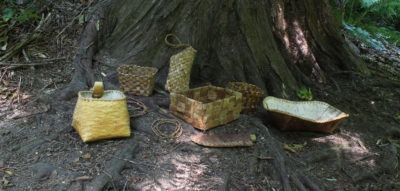
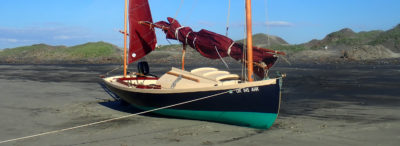
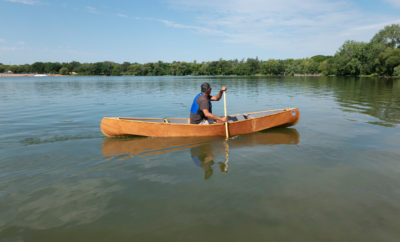
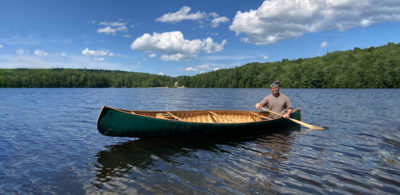
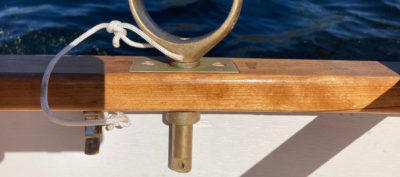
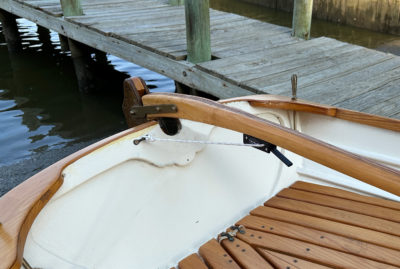
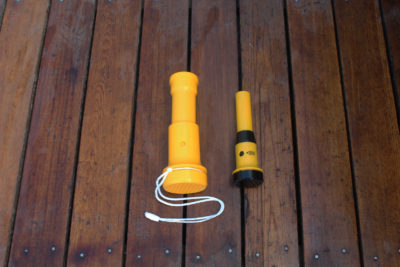

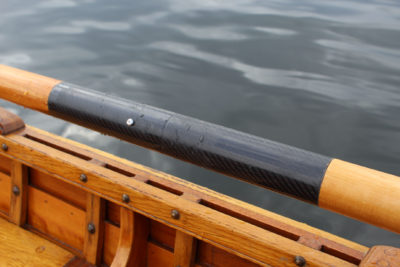
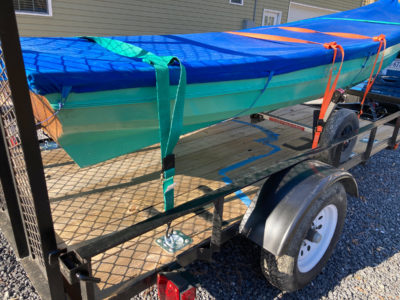

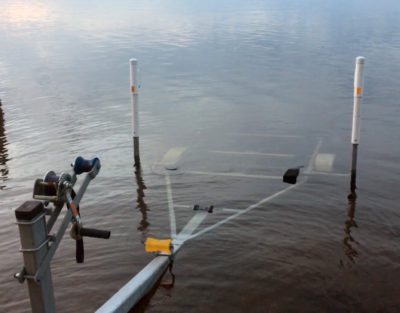
I have installed these on both pocket cruisers
I’ve built, an 18’8″ Winter Wren and 21’3″ Song Wren designed by Sam Devlin. They’re simple, trouble-free, and effective. With careful adjustment they will even serve as a poor man’s autopilot for a minute or so, enough to step away from the helm to grab a tool or a sandwich. Highly recommended.
I installed a Tiller clutch on my recently-built Tad Roberts’ CoPogy 18 design, a mini-motorsailer with an outboard in a well, directly ahead of the transom-hung rudder. While this arrangement gives very good control under power, it is not stable, so the clutch is absolutely critical, as Larry Cheek has said, for keeping control while stepping away from the helm momentarily. It also can provide relief under sail from long periods of steering once the sails are balanced.
I used a similar product on my boats for over thirty years, and it proved an invaluable aid to singlehanded sailing. However, I would recommend that the attachment points for the control line, rather than being close to the rudder, are taken out to the transom quarter knees or even to the inside of the gunwales. Theoretically they should be positioned on the circumference scribed by the fitting, as the tiller’s moves through its radius.
Yes, on a bigger boat, the control line can be move out as Dick describes. On our 14 footer it is plenty, and we did check in with Pete, the designer, to see if there might be issues, he said none other than a few degrees of tiller play, which doesn’t amount to much on our small boat but would be more noticed on a larger boat/rudder. The outings in our Penobscot, ST. JACQUES, when we would employ the TillerClutch as I installed it are basically floating picnics. I picked the mounting points as I did so that Skipper can still lounge on the transom. As for me sailing alone, if I do more of it and want to, I can add a second set of eye straps either on the quarter knees or gunwales. I left the control line cut long with that in mind.
To get over the ‘radius’ problem, rather than cord I use substantial ‘bungee’ that traps under a simple forward facing hand-carved oak jamb-cleat under the tiller. When not in use, the bungee is allowed to hang down. It has the benefit of a bit of ‘give’ when you need to over-ride it for a second or two, and no shock loads on attachment points.
As an alternate tweak for the control line, I have mine led to a couple of jam cleats attached to the inside of the gunwales. That way, it allows me to quickly cast off either side to easily get at the anchor, which is stowed in a locker just aft on the starboard side, and the fuel tank for the outboard motor, stored in the corresponding locker on the port side.
The jam cleats also make it easy to get just the right amount of tension on the control line.